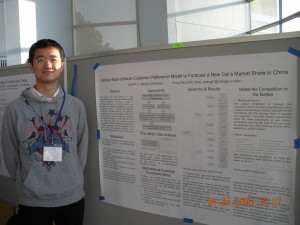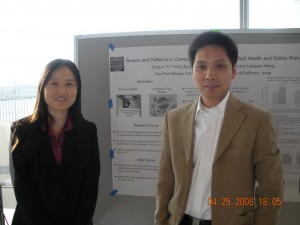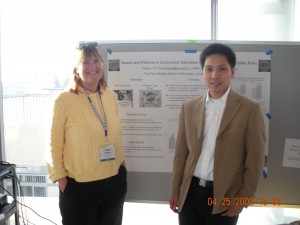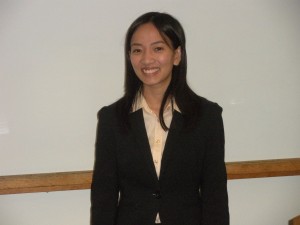1. L. Robin Keller, “The Effects of Problem Representation on the Sure-Thing and Substitution Principles”, Management Science, Volume 31, No. 6, June 1985, pp. 738-751.
2. L. Robin Keller, “An Empirical Investigation of Relative Risk Aversion”, Keller #02, IEEE Transactions on Systems, Man, and Cybernetics, Volume 15, No. 4, 1985, pp. 475-482.
3. L. Robin Keller, “Testing the ‘Reduction of Compound Alternatives’ Principle”, Keller #03, OMEGA, The International Journal of Management Science, Volume 13, No. 4, July-August, 1985, pp. 349-358.
4. L. Robin Keller, Rakesh K. Sarin, and Martin Weber, “Empirical Investigation of Some Properties of the Perceived Riskiness of Gambles”, Organizational Behavior and Human Decision Processes, Volume 38, August 1986, pp. 114-130.

Prof. Martin Weber, Mannheim
5. L. Robin Keller and Rakesh K. Sarin, “Equity in Social Risk: Some Empirical Observations”, Risk Analysis, Volume 8, No. 1, March 1988, pp. 135-146.
Email LRKeller@uci.edu for a printed copy.
6. L. Robin Keller and Joanna Ho, “Decision Problem Structuring: Generating Options”, IEEE Transactions on Systems, Man, and Cybernetics, Vol. 18, No. 5, September 1988, pp. 715-728. Keller #06 generating options
7. Peter H. Farquhar and L. Robin Keller, “Preference Intensity Measurement”, Annals of Operations Research, Vol. 19, 1989, pp. 205-217.
8. L. Robin Keller, “The Role of Generalized Utility Theories in Descriptive, Prescriptive, and Normative Decision Analysis”, Information and Decision Technologies, Vol. 15, 1989, pp. 259-271.
9. L. Robin Keller, “Decision Research with Descriptive, Normative, and Prescriptive Purposes-Some Comments”, Annals of Operations Research, Vol. 19, (volume on Choice Under Uncertainty edited by Peter Fishburn and Irving H. LaValle), 1989, pp. 485-487. (Entire edited volume won 1991 Decision Analysis Publication Award from the ORSA Decision Analysis Special Interest Group.)

10. Richard L. Daniels and L. Robin Keller, “An Experimental Evaluation of the Descriptive Validity of Lottery Dependent Utility Theory”, Journal of Risk and Uncertainty, Vol. 3, 1990, pp. 115-134.
11. Richard L. Daniels and L. Robin Keller, “Choice-Based Assessment of Utility Functions”, Organizational Behavior and Human Decision Processes, Vol. 52, 1992, pp. 524-543.
12. L. Robin Keller, Uzi Segal, and Tan Wang, “The Becker-de Groot-Marschak Mechanism and Generalized Utilized Theories: Theoretical Predictions and Empirical Observations”, Theory and Decision, 34:83-97, 1993.
13. Stuart Eriksen and L. Robin Keller, “A Multi-Attribute Utility Approach to Weighing the Risks and Benefits of Pharmaceutical Agents”, Medical Decision Making, 1993; 13:118-125.
14. Joanna Ho and L. Robin Keller, “The Effect of Inference Order and Experience-Related Knowledge on Diagnostic Conjunction Probabilities”, Organizational Behavior and Human Decision Processes, 1994; 59: 51-74.
15. L. Robin Keller and Rakesh K. Sarin, “Fair Processes for Societal Decisions Involving Distributional Inequalities”, Risk Analysis, Vol. 15, No. 1 (February 1995), pp. 49-59.
Email LRKeller@uci.edu for a copy of the printed paper.
16. Lauraine G. Chestnut, L. Robin Keller, William E. Lambert, and Robert Rowe, “Measuring Heart Patients’ Willingness to Pay for Changes in Angina Symptoms”, Medical Decision Making, January-March, Vol. 16, 1996, pp. 65-77.

17. L. Robin Keller and Craig W. Kirkwood, “The Founding of INFORMS: A Decision Analysis Perspective”, Operations Research, 47 (1), January-February 1999, 16-28.

18. Young-Hee Cho, L. Robin Keller, and M. Lynne Cooper, “Applying Decision-Making Approaches to Health Risk-Taking Behaviors: Progress and Remaining Challenges”, Journal of Mathematical Psychology, 43(2), June 1999, 261-285.
19. Wen-Qiang Bian and L. Robin Keller, “Chinese and Americans Agree on What Is Fair, but Disagree on What Is Best in Societal Decisions Affecting Health and Safety Risks”, Risk Analysis, 19 (3), 1999, 433-446. Email LRKeller@uci.edu for a printed copy. http://onlinelibrary.wiley.com/doi/10.1111/j.1539-6924.1999.tb00419.x/abstract
20. Wen-Qiang Bian and L. Robin Keller, “Patterns of Fairness Judgments in North America and the People’s Republic of China”, Journal of Consumer Psychology, 8 (3), 1999, 301-320.

21. Monika I. Winn and L. Robin Keller, “A Modeling Methodology for Multi-Objective Multi-Stakeholder Decisions: Implications for Research”, Journal of Management Inquiry, Vol. 10, No. 2, June 2001, 166-181. (Winner of the “Breaking the Frame Award” at Western Academy of Management meeting in March 2002 by the Journal of Management Inquiry for best paper of 2001. )
22. L. Robin Keller and Elisabetta Strazzera “Examining Predictive Accuracy Among Discounting Models”, Journal of Risk and Uncertainty, Vol. 24:2, 143-160, 2002. Keller #22
 UCI’s Dr. Thomas Eppel
UCI’s Dr. Thomas Eppel

23. Jeffery L. Guyse, L. Robin Keller and Thomas Eppel “Valuing Environmental Outcomes: Preferences for Constant or Improving Sequences”, Organizational Behavior and Human Decision Processes, Vol. 87, No. 2, March 2002, 253-277. (recipient of finalist award in Decision Analysis Society of INFORMS Student Paper Competition)
24. Joanna L. Ho, L. Robin Keller, and Pam Keltyka, “Managers’ Variance Investigation Decisions: An Experimental Examination of Probabilistic and Outcome Ambiguity”, Journal of Behavioral Decision Making, 14, 257-278, 2001.
25. Joanna L. Ho, L. Robin Keller, and Pam Keltyka, “Effects of Outcome and Probabilistic Ambiguity”, Journal of Risk and Uncertainty, 24 (2002) 1: 47-74.

26. Joanna L. Ho, L. Robin Keller, and Pamela Keltyka, “How Do Information Ambiguity and Timing of Contextual Information Affect Managers’ Goal Congruence in Making Investment Decisions in Good Times vs. Bad Times?”, Journal of Risk and Uncertainty, 31 (Sept. 2005) 2: 163-186.
27. S. David Brazer and L. Robin Keller, “A Conceptual Framework for Multiple Stakeholder Educational Decision Making”, International Journal of Education Policy and Leadership, Volume 1, number 3, pages 1-14. September 18, 2006, retrieved from http://www.ijepl.org.
28. Tianjun Feng and L. Robin Keller, “A Multiple-Objective Decision Analysis for Terrorism Protection: Potassium Iodide Distribution in Nuclear Incidents”, Decision Analysis, (June 2006), 3 (2): 76-93.
29. L. Robin Keller, Rakesh K. Sarin, Jayavel Sounderpandian, “An Examination of Ambiguity Aversion: Are Two Heads Better Than One?”, Judgment and Decision Making, (Dec. 2007) 2(5), 390-397. (Appeared in Dec. 2007, vol. 2, issue 6, but header on paper says issue 5.) Accepted 12-2007.
30. Tianjun Feng, L. Robin Keller, Xiaona Zheng. 2008. “Modeling Multi-Objective Multi-Stakeholder Decisions: A Case-Exercise Approach”, INFORMS Transactions on Education, 8(3) 103-114. http://dx.doi.org/10.1287/ited.1080.0012
31. L. Robin Keller, Craig W. Kirkwood (Arizona State University), and Nancy S. Jones, (Baltimore Metropolitan Council). 2010. “Assessing Stakeholder Evaluation Concerns: An Application to the Central Arizona Water Resources System”, Systems Engineering. Volume 13(1), 58-71.
32. Tianjun Feng (UCI Merage doctoral alumnus, Associate Professor professor at Fudan University), L. Robin Keller, Xiaona Zheng (Associate Professor at Peking University and former Merage doctoral student, who graduated from Duke when she moved there with our Prof. Jeannette Song), 2011, “Decision Making in the Newsvendor Problem: A Cross-national Laboratory Study”, OMEGA, The International Journal of Management Science. 39(1) 41-50.
Associate Prof. Xiaona Zheng
Guanghua School of Management
Peking University
Profs. Liangyan Wang and Tianjun Feng
33. Tianjun Feng (UCI Merage doctoral alumnus, Associate Professor at Fudan University), L. Robin Keller, Liangyan Wang (UCI Merage doctoral alumna, Associate Professor and Department Chair (2015) at Shanghai Jiao Tong University), and Yitong Wang (UCI Merage doctoral alumnus, now a Lecturer (i.e., assistant professor) at University Technology Sydney). “Product Quality Risk Perceptions and Decisions: Contaminated Pet Food and Lead-Painted Toys”, Risk Analysis, October 2010, 30(10), 1572–1589. Email LRKeller@uci.edu for a printed copy.
Working paper version of accepted paper:
Product_Quality_Risk_Perceptions-FINAL-web-posting-

34. James M. Leonhardt (Marketing doctoral student at the time, then Assistant Professor, New Mexico State, then at Univ. of Nevada, Reno), L. Robin Keller and Cornelia Pechmann, October 2011,“Avoiding the Risk of Responsibility by Seeking Uncertainty: Responsibility Aversion and Preference for Indirect Agency When Choosing for Others”, Journal of Consumer Psychology. 21(4) 405-413. doi:10.1016/j.jcps.2011.01.001 Corrected Proof, Available online 15 March 2011. http://www.sciencedirect.com/science/article/pii/S1057740811000155. Working paper version available at SSRN: http://ssrn.com/abstract=2015956. Leonhardt received a finalist award in the 2013 Decision Analysis Society of INFORMS Student Paper competition for this paper.
Abstract: Uncertainty-seeking behavior is currently understood as the result of loss aversion which motivates a preference for the possibility to avoid or lessen an otherwise sure loss. However, when choosing among negative options on behalf of others, we offer responsibility aversion as another possible motive for uncertainty-seeking behavior. Within our conceptual model, responsibility aversion is defined as the preference to minimize one’s causal role in outcome generation. Compared to certain options, uncertain options lessen the decision maker’s causal role in outcome generation because the outcomes are partially determined by chance. The presence of chance increases indirect agency on behalf of the decision maker and lessens his or her perceived risk of responsibility. The results of five studies support a responsibility aversion motivation behind uncertainty-seeking behavior.
35. Dipayan Biswas (UCI Merage doctoral alumnus, Bentley College at the time, Professor, University of South Florida), L. Robin Keller, Bidisha Burman (Appalachian State), “Making Probability Judgments of Future Product Failures: The Role of Mental Unpacking ” Journal of Consumer Psychology. April 2012. 22(2), 237-248. doi:10.1016/j.jcps.2011.03.002 Corrected Proof, Available online 27 April 2011. http://www.sciencedirect.com/science/article/pii/S1057740811000283.
Abstract: When consumers mentally unpack (i.e., imagine) the reasons for product failure, their probability judgments of future product failures are higher than when no mental unpacking is undertaken. However, increasing the level of mental unpacking does not lead to monotonically increasing effects on probability judgments but results in inverted U-shaped relationships. Using a two-factor structure, we propose that when consumers undertake mental unpacking, there will be two conflicting processes; while imagining causes for an event will lead to greater perceived probability, the greater difficulty in generating reasons for an event will lead to lower perceived probability.

36. Yitong Wang (UCI Merage doctoral alumnus, Assistant Professor, Tsinghua University when accepted, now a Lecturer (i.e., assistant professor), University of Technology, Sydney), Tianjun Feng (UCI Merage doctoral alumnus, Associate Professor at Fudan University), L. Robin Keller, “A Further Exploration of the Uncertainty Effect”, Journal of Risk and Uncertainty, accepted 1-25-2013, Published ‘Online First’ on SpringerLink on 11-24-13; December 2013 47(3) 291-310.
http://link.springer.com/article/10.1007%2Fs11166-013-9180-x

Email author for printed version: LRKeller@uci.edu
Abstract: Individual valuation of a binary lottery at values less than the lottery’s worst outcome has been designated as the “uncertainty effect”. Our paper aims to explore the boundary conditions of the uncertainty effect by investigating a plausible underlying process and proposing two possible methods. First, we examine how providing an exogenous evaluation opportunity prior to judging the value of the lottery affects individuals’ judgments, and find that first valuing the worst outcome and then the lottery eliminates the uncertainty effect. Second, we explore if introducing additional cognitive load dampens how far decision makers correct their initial evaluations, and find that additional cognitive load is able to eliminate the uncertainty effect.
37. Tianjun Feng (UCI Merage doctoral alumnus, Associate Professor at Fudan University), L. Robin Keller, Ping Wu (Fudan University), Yifan Xu (Fudan University), 2014, “An Empirical Study of the Toxic Capsule Crisis in China: Risk Perceptions and Behavioral Responses”, Risk Analysis, 34(4), 698-710. Accepted 6-18-2013, online in early view on 7-16-13, doi: 10.1111/risa.12099.
http://onlinelibrary.wiley.com/doi/10.1111/risa.12099/abstract.
Capsule-R2-accepted- can post 6 months after print 7-23-13
Accepted Working Paper version, allowed to be posted.
Abstract: The outbreak of the toxic capsule crisis during April 2012 aroused widespread public concern about the risk of chromium-contaminated capsules and drug safety in China. In this paper, we develop a conceptual model to investigate risk perceptions of the pharmaceutical drug capsules and behavioral responses to the toxic capsule crisis and the relationship between associated factors and these two variables. An online survey was conducted to test the model, including questions on the measures of perceived efficacy of the countermeasures, trust in the State FDA (Food and Drug Administration), trust in the pharmaceutical companies, trust in the pharmaceutical capsule producers, risk perception, concern, need for information, information seeking, and risk avoidance. In general, participants reported higher levels of risk perception, concern, and risk avoidance, and lower levels of trust in the three different stakeholders. The results from the structural equation modeling procedure suggest that perceived efficacy of the countermeasures is a predictor of each of the three trust variables; however, only trust in the State FDA has a dampening impact on risk perception. Both risk perception and information seeking are significant determinants of risk avoidance. Risk perception is also positively related to concern. Information seeking is positively related to both concern and need for information. The theoretical and policy implications are also discussed.

38. Jay Simon (Merage doctoral alumnus, professor at American University as of summer 2015), Craig W. Kirkwood (Emeritus Professor, W. P. Carey School of Business, Arizona State University), L. Robin Keller, “Decision Analysis with Geographically Varying Outcomes: Preference Models and Illustrative Applications”, Operations Research, 62(1), Jan.-Feb. 2014, 182-194. Online in Articles in Advance on Dec. 16, 2013.
Printed paper: opre 2013 1217-2au_copy
Supplement Simon et al. 2014 supplement: http://pubsonline.informs.org/doi/suppl/10.1287/opre.2013.1217/suppl_file/opre.2013.1217-sm.pdf Abstract, and link to paper pdf: http://pubsonline.informs.org/doi/abs/10.1287/opre.2013.1217
Abstract: This paper presents decision analysis methodology for decisions based on data from geographic information systems. The consequences of a decision alternative are modeled as distributions of outcomes across a geographic region. We discuss conditions which may conform with the decision maker’s preferences over a specified set of alternatives; then we present specific forms for value or utility functions that are implied by these conditions. Decisions in which there is certainty about the consequences resulting from each alternative are considered first; then probabilistic uncertainty about the consequences is included as an extension. The methodology is applied to two hypothetical urban planning decisions involving water use and temperature reduction in regional urban development, and fire coverage across a city. These examples illustrate the applicability of the approach and the insights that can be gained from using it.
39. Lindsey E. Minion, MD (Univ. of Arizona Cancer Center & Creighton University at St. Joseph’s Hospital and Medical Center, Phoenix); Jiaru Bai (Merage doctoral student); Bradley J. Monk, MD (Gynecologic Oncology, UCI); L. Robin Keller, PhD; Ramez N. Eskander, MD (Gynecologic Oncology, UCI); Gareth K. Forde, MD, PhD, MBA (Gynecologic Oncology, UCI) ; John K. Chan, MD (California Pacific Palo Alto Medical Foundation, Sutter Cancer Institute, San Francisco), Krishnansu S. Tewari (Gynecologic Oncology, UCI), “A Markov Model to Evaluate Cost-Effectiveness of Antiangiogenesis Therapy Using Bevacizumab in Advanced Cervical Cancer”, Gynecologic Oncology, Vol. 137, Issue 3, June 2015, pages 490-496. Accepted 2-28-2015.
http://www.sciencedirect.com/science/article/pii/S0090825815006769#.
First available online on 10 March 2015 at
http://www.sciencedirect.com/science/article/pii/S0090825815006769#MMCvFirst,
Erratum: In the transitions probability Table 2, the probability of going from “severe complications” to “progress” in one month is 0.9 (not 0), and the probability of going from “severe complications” to “die” is 0 (not 0.9), for both treatment options.
KEYWORDS: Cost-effectiveness, antiangiogenesis therapy, cervical cancer, bevacizumab, Markov model
Purpose: To evaluate the cost-effectiveness of bevacizumab in recurrent/persistent and metastatic cervical cancer.
Methods: Using the phase III randomized trial, Gynecologic Oncology Group protocol 240 a Markov decision tree was created. Costs were obtained from the 2013 MediCare Services Drug Payment Table and Physician Fee Schedule. A 5-year model was used with subjects in the following states: response, progression, minor complications, severe complications, death. Patients experiencing a health utility per month according to the effectiveness of the treatment were calculated. Because survival for patients with advanced disease is measured in months rather than years, results were reported in both quality adjusted cervical cancer life months and years (QALmonth, QALY), adjusted from a baseline of having advanced cervical cancer during a month.
Results: The estimated total cost of therapy with bevacizumab is approximately 13.3 times that for chemotherapy alone, adding $73,159 per 3.0 months (0.25 year) of life gained. The incremental cost-effectiveness ratio (ICER) increased to $27,096/QALmonth ($325,152/QALY) due to the smaller difference in QALmonths. With a 75% bevacizumab cost reduction, the ICER is $7,358/QALmonth ($88,296/ QALY), which translates to $19,866 for the 3.0 month (0.25 year) gain in OS.
Conclusions: Increased costs associated with bevacizumab therapy for advanced cervical cancer is primarily related to the cost of the drug and not the management of bevacizumab-induced complications. Cost reductions in bevacizumab result in dramatic declines in the ICER, suggesting that cost reconciliation of effective antiangiogenesis therapy in advanced cervical cancer may be possible through the availability of biosimilars, and/or less expensive, equally efficacious anti-angiogenesis agents.
Merage Doctoral student Jiaru Bai (3rd from left, at her final defense), with Yiwei Wang, Ali Esmaeeli, and Vahid Nourbakhsh
40. Yitong Wang (University Technology Sydney), Liangyan Wang (Shanghai Jiao Tong University), L. Robin Keller, “Discounting over Subjective Time: Subjective Time Perception Helps Explain Multiple Discounted Utility Anomalies”, accepted in August 2015, International Journal of Research in Marketing, 32 (2015) pp. 445–448, Final version published online: 30-NOV-2015, DOI information:
10.1016/j.ijresmar.2015.08.006, http://dx.doi.org/10.1016/j.ijresmar.2015.08.006
Abstract: Consumers often face choices involving intertemporal tradeoffs. Existing research suggests that decision makers in general do not obey discounted utility theory because their discount rates are context dependent. Recent literature incorporates decision makers’ subjective perception of time into the classic discounted utility model and finds relatively constant discount rates over subjective time. In addition to replicating previous work, we investigated the missing component – the magnitude effect, provided a holistic view via a more comprehensive experiment including multiple anomalies, and found that subjective time perception was able to explain most of the anomalies simultaneously in a single scenario.
41. Baozhou LU, Tao ZHANG, Liangyan WANG (Merage Ph.D. alumna), L. Robin KELLER, “Trust Antecedents, Trust and Online Microsourcing Adoption: An Empirical Study from the Resource Perspective”, Decision Support Systems, 85 (May 2016) pp. 104–114, accepted March 2016.
http://www.sciencedirect.com/science/article/pii/S0167923616300288
E-mail addresses: bzlu@upc.edu.cn (Baozhou Lu), zhangtao@upc.edu.cn (Tao Zhang), WLY@sjtu.edu.cn (Liangyan Wang)
Abstract: The online microsourcing marketplace is a new form of outsourcing that is organized over online platforms for the performance of relatively small service tasks. Microsourcing offers a more flexible way to hire contract workers or to outsource. Prior research indicates the importance of individual-level trust when choosing providers in online sourcing marketplaces. We argue that institution-based trust is also crucial for online microsourcing adoptions. Drawing on a trust framework adapted from prior literature, this paper uncovers the trust-building mechanisms in online microsourcing marketplaces, as well as the marketplace-related attributes for online microsourcing adoption. The proposed research model is tested with a data set collected from the clients of a typical marketplace in China – zhubajie.com. The findings suggest that perceptions of resource-based attributes of a marketplace, together with the perceived effectiveness of its intermediary role, can help to build trust towards the marketplace, enhancing trust towards the community of providers and driving the intent to adopt online microsourcing. Thus, this paper confirms the roles of online marketplaces as both the resource pool and the transaction intermediary from the perspective of clients. Finally, this paper not only indicates the relevance of resource theories in understanding this new trend in outsourcing, but also suggests the importance of trusted relational governance in governing online microsourcing transactions.
42. Liangyan WANG (Merage alumna and Associate Professor of Marketing, Antai Management School, Shanghai Jiao Tong University, Shanghai, 200052, WLY@sjtu.edu.cn), Shijian WANG (just graduated student of marketing, kasano@sjtu.edu.cn), L. Robin KELLER, Jie LI (Assoc. Prof. of Market., Antai Mgt Sch.), “Thinking Styles Affect Reactions to Brand Crisis Apologies”, Sept. 2016, European Journal of Marketing, Vol. 50, Issue 7/8, 1263-1289, accepted in March 2016.
Emerald Early Cite version (author accepted manuscript form): http://www.emeraldinsight.com/doi/pdfplus/10.1108/EJM-07-2014-0457; abstract: http://www.emeraldinsight.com/doi/abs/10.1108/EJM-07-2014-0457
Permanent link: http://dx.doi.org/10.1108/EJM-07-2014-0457
Purpose – This article examines how a person’s thinking style, specifically holistic versus analytic, and a firm’s crisis apology with the remedial solution framed in “why” (vs. “how”) terms can interactively impact consumers’ perceived efficacy of the firm to respond to the crisis and their impression or evaluation of the brand.
Design/methodology/approach – Hypotheses were tested through three experimental studies involving 308 participants recruited in China. Participants answered survey questions investigating the interactive effects from consumers’ thinking style (culture as a proxy in study 1, measured in study 2 or primed in study 3) and a brand’s crisis apology with the remedial solution framed in “why” (vs. “how”) terms on consumers’ perceived efficacy and evaluation of the firm.
Findings –The frame of the remedial solution resulting in a higher evaluation improvement depended on a consumer’s thinking style. For holistic thinkers, a “why” (vs. “how”) framed remedial solution resulted in a higher evaluation improvement; however, for analytic thinkers, a “how” (vs. “why”) framed remedial solution resulted in a higher evaluation improvement. Additionally, the results showed that a consumer’s perceived efficacy of the brand being able to successfully respond to the crisis mediated the interactive effects of the remedial solution framing and thinking styles on the evaluation improvement.
Research limitations/implications – Different ways of framing the remedial solution in a firm’s apology will have different impacts on people with different thinking styles. Participants in studies 2 and 3 were recruited from samples on campus in China. Additionally, the automobile brand used in this study is fictional to avoid prior brand name or brand commitment impact.
Practical implications – Our findings provide evidence that framing of the remedial solution can be leveraged as a tool to reduce negative impact resulting from a brand crisis. Specifically, our results suggest that companies may do well to employ a “why” framed remedial solution, particularly in cases where consumers are likely to process information holistically. Conversely, a “how” framed remedial solution may be effective in situations where consumers are likely to process information analytically.
Originality/value – This research contributes to the literature, being among the first to consider how the remedial solution framing in a firm’s apology can enhance people’s evaluation of the brand and decrease the perceived negative impact resulting from the brand crisis.
This research was funded by the National Natural Science Foundation of China Grant (71072059) and Shanghai Shuguang Program Grant (13SG16) to Liangyan Wang.
43. Jiaru Bai (Merage doctoral student), Cristina del Campo (Universidad Complutense de Madrid and UCI visitor in 2016), L. Robin Keller, “Markov Chain Models in Practice: A Review of Low Cost Software Options”, Publication in English, also available in Spanish: “Modelos de Cadenas de Markov en la Práctica: Una Revisión de Opciones de Software de Bajo Coste”, 2017, Investigación Operacional, Vol. 38(1), pages 56-62, http://rev-inv-ope.univ-paris1.fr/volumes-since-2000/volume-38-2017/, accepted May 30, 2016. Journal website: http://rev-inv-ope.univ-paris1.fr/, celebrating 50th anniversary of publication in 2016.
This paper was written in Spanish (and English) to facilitate communication with Spanish-speaking scholars in Cuba and elsewhere, who aim to conduct Markov cost effectiveness analyses and would benefit from low cost software alternatives. The working paper is in English and Spanish versions:
investigacion_operacional_2016_09_14_bai_delcampo_keller_english,
investigacion_operacional_2016_Bai_delCampo_Keller
Abstract: Markov processes (or Markov chains) are used for modeling a phenomenon in which changes over time of a random variable comprise a sequence of values in the future, each of which depends only on the immediately preceding state, not on other past states. A Markov process (PM) is completely characterized by specifying the finite set S of possible states and the stationary probabilities (i.e. time-invariant) of transition between these states. The software most used in medical applications is produced by TreeAge, since it offers many advantages to the user. But, the cost of the TreeAge software is relatively high. Therefore in this article two software alternatives are presented: Sto Tree and the zero cost add-in program “markovchain” implemented in R. An example of a cost-effectiveness analysis of two possible treatments for advanced cervical cancer, previously conducted with the Treeage software, is re-analyzed with these two low cost software packages.
RESUMEN (en Español): Los procesos de Markov (o cadenas de Markov) se utilizan para el modelización de un fenómeno en el que el cambio con el tiempo de una variable aleatoria comprenden una secuencia de valores en el futuro, cada uno de los cuales depende únicamente del estado inmediatamente anterior, no de otros estados pasados. Un proceso de Markov (PM) se caracteriza por completo mediante la especificación del conjunto S finito de estados posibles y las probabilidades estacionarias (es decir, invariante en el tiempo) de transición entre esos estados. El software más utilizado en aplicaciones médicas es producido por TreeAge, ya que ofrece muchas ventajas para el usuario. Pero, el coste del software TreeAge es relativamente alto. Por lo tanto, en este artículo se presentan dos alternativas de software: Sto Tree y el paquete, gratuito, “markovchain” implementado en R. Un ejemplo de un análisis de coste-efectividad de dos tratamientos posibles para el cáncer de cuello uterino avanzado, llevado a cabo previamente con el software TreeAge, se volvió a analizar con estos dos paquetes de software de bajo coste.

Prof. Cristina del Campo Campos with Jay Simon at INFORMS reception (at Houston Astros field during Dodgers-Astros World Series game in LA)
Prof-Cristina-del-Campo-Campos photo
44. L. Robin Keller and Yitong Wang (Merage doctoral alumnus) “Information Presentation in Decision and Risk Analysis: Answered, Partly Answered and Unanswered Questions”, 2017, Risk Analysis, 37(6): 1132–1145; accepted August 7, 2016. http://onlinelibrary.wiley.com/doi/10.1111/risa.12697/full. Email LRKeller@uci.edu for a printed copy.
Appeared online in early view prior to print: Version of Record online: 21 SEP 2016 | DOI: 10.1111/risa.12697 Abstract
Keller+Wang-44-accepted version Word format of author accepted version
Keller+Wang-44-accepted version pdf format
For the last thirty years, researchers in risk analysis, decision analysis, and economics have consistently proven that decision makers employ different processes for evaluating and combining anticipated and actual losses, gains, delays and surprises. While rational models generally prescribe a consistent response, people’s heuristic processes will sometimes lead them to be inconsistent in the way they respond to information presented in theoretically equivalent ways. We point out several promising future research directions by listing and detailing a series of answered, partly answered, and unanswered questions.
45. Luping Sun, Xiaona Zheng, Meng Su, L. Robin Keller (2017), “Intention-Behavior Discrepancy of Foreign versus Domestic Brands in Emerging Markets: The Relevance of Consumer Prior Knowledge,” Journal of International Marketing, published by the American Marketing Association, 25(1), pp. 91-109, accepted October 20, 2016. doi: http://dx.doi.org/10.1509/jim.15.0123.
keller-45-author-accepted-sun-zheng-su-keller-intention-behavior-discrepancy
Most research on the performance of foreign versus domestic brands in emerging markets examines measures of product evaluation or purchase intention. However, consumers intending to buy a product may switch to competing brands, displaying an intention-behavior discrepancy (IBD). Drawing upon literature on country associations and dual process theory, we examine the difference in IBD of foreign versus domestic brands in emerging markets and the moderating role of prior knowledge. We conducted an intention survey followed by a post-purchase survey in the Chinese automobile and smartphone industries. We found that foreign brands have an advantage on IBD relative to domestic brands, indicating that they have the dual advantage of higher evaluations and lower IBDs. Furthermore, foreign brands’ advantage on IBD is smaller for consumers with inaccurate prior knowledge, as they are more likely to systematically reprocess information and discount foreign brands’ favorable country associations. For these consumers, overestimating the product reduces foreign brands’ advantage to a smaller degree than underestimating it due to confirmation bias. These findings provide implications for brands in emerging markets.
46. L. Robin Keller, Jay Simon (Merage PhD alumnus), January 2019, “Preference Functions for Spatial Risk Analysis”, Risk Analysis, 39(1), pp. 244-256, in Special Issue: Advances in Spatial Risk Analysis, accepted 7-31-17, submitted 6-2016, Version of Record appeared online in early view prior to print: Sept. 7, 2017: Abstract Article PDF(1822K). In print in Volume 39, Issue1, https://doi.org/10.1111/risa.12892
The top journal in its field, Risk Analysis is the journal of the Society for Risk Analysis.
When outcomes are defined over a geographic region, measures of spatial risk regarding these outcomes can be more complex than traditional measures of risk. One of the main challenges is the need for a cardinal preference function that incorporates the spatial nature of the outcomes. We explore preference conditions that will yield the existence of spatial measurable value and utility functions, and discuss their application to spatial risk analysis. We also present a simple example on household freshwater usage across regions to demonstrate how such functions can be assessed and applied.
47. James Leonhardt (Merage PhD alumnus, at Univ. of Nevada, Reno), L. Robin Keller, “Do Pictographs Affect Probability Comprehension and Risk Perception of Multiple-Risk Communications?” Journal of Consumer Affairs, Fall 2018, 52(3), pp. 756-769, accepted 12-22-17, published in Early View on 4-6-2018. http://dx.doi.org/10.1111/joca.12185
Pictographs can be used to visually present probabilistic information using a matrix of icons. Previous research on pictographs has focused on single rather than multiple-risk options. The present research conducts a behavioral experiment to assess the effect of pictographs on probability comprehension and risk perception for single and multiple-risk options. The creation of the experimental stimuli is informed by a review of the Centers for Disease Control and Prevention’s vaccine information sheets. The results provide initial evidence that, in the context of childhood vaccines, the inclusion of pictographs alongside numeric (e.g. 1 in 5) probability information can result in higher probability comprehension and lower risk perception for multiple-risk options but not for single-risk options. These findings have implications for how health-related risks are communicated to the public.
48. Cristina del Campo (Merage visitor in 2019 and 2016, Universidad Complutense de Madrid), Jiaru Bai (UCI Merage PhD alumna, Wake Forest Assistant Professor), L. Robin Keller, “Comparing Markov and non-Markov Alternatives for Cost-effectiveness Analysis: Insights from a Cervical Cancer Case”, Operations Research for Health Care. Volume 21, June 2019, Pages 32-43. https://doi.org/10.1016/j.orhc.2019.04.001
Accepted 4-1-2019, posted online 4-3-19 prior to final proof edits: https://www.sciencedirect.com/science/article/pii/S2211692318301097#!
Markov models allow medical prognosis to be modeled with health state transitions over time and are particularly useful for decisions regarding diseases where uncertain events and outcomes may occur. To provide sufficient detail for operations researchers to carry out a Markov analysis, we present a detailed example of a Markov model with five health states with monthly transitions with stationary transition probabilities between states to model the cost and effectiveness of two treatments for advanced cervical cancer A different approach uses survival curves to directly model the fraction of patients in each state at each time period without the Markov property. We use this alternative method to analyze the cervical cancer case and compare the Markov and non-Markov approaches. These models provide useful insights about both the effectiveness of treatments and the associated costs for healthcare decision makers.
49. Jeffery L. Guyse (Merage alumnus, Technology and Operations Management, College of Business Administration, California State Polytechnic University, Pomona), L. Robin Keller, Candice H. Huynh (Merage alumna, Cal Poly, Pomona), “Valuing Sequences of Lives Lost or Saved Over Time: Preference for Uniform Sequences”, Decision Analysis, 17(1):24-38, March 2020, https://doi.org/10.1287/deca.2019.0397, accepted June 5, 2019. Author accepted version dated May 20, 2019. Published online in advance of print at https://pubsonline.informs.org/toc/deca/0/0; https://pubsonline.informs.org/doi/pdf/10.1287/deca.2019.0397 on 2-19-2020.
Winner of the 2020 Clemen-Kleinmuntz Decision Analysis Best Paper Award ($2000) for best paper of the year in the journal
Policymakers often make decisions involving human mortality risks and monetary outcomes that span across different time periods and horizons. Many projects or environmental regulation policies involving risks to life, such as toxic exposures, are experienced over time. The preferences of individuals on lives lost or saved over time should be understood to implement effective policies. Using a within-subject survey design, we investigated our participants’ elicited preferences (in the form of ratings) for sequences of lives saved or lost over time at the participant level. The design of our study allowed us to directly observe the possible preference patterns of Negative Time Discounting or a Preference for Spreading from the responses. Additionally, we embedded factors associated with three other prevalent anomalies of intertemporal choice (Gain/Loss Asymmetry, Short/Long Asymmetry, and the Absolute Magnitude Effect) into our study for control. We find that our participants exhibit three of the anomalies: Preference for Spreading, Absolute Magnitude Effect and Short/Long Term Asymmetry. Furthermore, fitting the data collected, Loewenstein and Prelec’s model for the valuation of sequences of outcomes allowed for a more thorough understanding of the factors influencing the individual participants’ preferences. Based on the results, the standard discounting model does not accurately reflect the value that some people place on sequences of mortality outcomes. Preferences for uniform sequences should be considered in policymaking, rather than applying the standard discounting model.
Candice Huynh
50. Jay Simon (Merage PhD alumnus, Associate Professor, American University), Donald Saari (Professor Emeritus, UCI Social Science), L. Robin Keller, “Interdependent Altruistic Preference Models”, Decision Analysis, 17(3), Sept. 2020, pp. 189-207, accepted 2-26-2020. https://pubsonline.informs.org/doi/abs/10.1287/deca.2020.0411 Published Online: 10 June 2020.
Finalist for the 2020 Decision Analysis Special Recognition Award (now called the Clemen-Kleinmuntz Decision Analysis Best Paper Award, for best paper of the year in the journal)
Altruistic preferences, or the desire to improve the well-being of others even at one’s own expense, can be difficult to incorporate into traditional value and utility models. It is straightforward to construct a multi-attribute preference structure for one decision maker that includes the outcomes experienced by others. However, when multiple individuals incorporate one another’s well-being into their decision making, this creates complex interdependencies that must be resolved before the preference models can be applied. We provide representation theorems for additive altruistic value functions for two-person, n-person, and group outcomes in which multiple individuals are altruistic. We find that in most cases it is possible to resolve the preference interdependencies and that modeling the preferences of altruistic individuals and groups is tractable.
Don Saari, UCI
51. James M. Leonhardt, University of Nevada, Reno (Merage PhD alumnus), L. Robin Keller, Ronald S. Lembke, University of Nevada, Reno, “Communicating Health Risks to the Public”, Przegląd Organizacji (Organization Review in English), 2021, number 1, pp. 39-44, accepted 1-20-2021.
Health risks, such as the probability of experiencing a side effect from a medication, are typically communicated numerically. However, presenting risks in strictly numeric formats is problematic considering that the public often experiences difficulty in comprehending strictly numeric probabilities. To help overcome this problem, Leonhardt and Keller (2018) tested the efficacy of using pictographs to visually present probabilistic information to health consumers. They found that the addition of pictographs alongside numeric probability information increased probability comprehension and lessened the perceived risk of a multiple risk health option. Here, we review relevant work on probability format and build on general evaluability theory to posit why pictographs may result in lower risk perceptions of multiple risk options. We discuss current limitations in our understanding of how the public perceives multiple risk options, and we highlight opportunities for future research. For instance, we introduce Quick Response (QR) codes as a potential tool to help consumers view health risks in multiple formats on the Internet.
(In a collaboration between Merage doctoral alumnus Jim Leonhardt’s University of Nevada, Reno (UNR) and SGH Warsaw School of Business, he gave a talk in Poland and was invited to contribute a refereed chapter in a book with papers by UNR-SGH collaborators. We co-authored a paper for that collection, which is now going to appear as a special issue in a Polish journal, Przegląd Organizacji (Organization Review in English).)
See also https://www.facebook.com/UCIMerage/posts/10157797275704900
52. Alexander Robinson (Merage PhD, CSX), L. Robin Keller, Cristina del Campo (Complutense University of Madrid, former Merage visitor), “Building Insights on True Positives vs. False Positives: Bayes’ Rule”, Decision Sciences Journal of Innovative Education, 20:4, October 2022, 224-234, accepted 2-27-2022, First published: June 15, 2022, in special issue on Teaching Data Analytics and Statistics. This is the peer reviewed accepted version, published in final form at https://onlinelibrary.wiley.com/doi/full/10.1111/dsji.12265. https://onlinelibrary.wiley.com/doi/10.1111/dsji.12265, https://onlinelibrary.wiley.com/toc/15404609/0/0
Alex Robinson  Cristina del Campo
Cristina del Campo 
Keller #52
Supplemental materials are freely available:
| Filename | Description |
| dsji12265-sup-0001-appendix.docx280.6 KB | Online Excel workbook: A dynamic spreadsheet allowing dynamic updating of data tables and stacked bar charts and dynamic graphs showing the relationship of inputs of sensitivity and specificity, for different priors, on positive predictive value and negative predictive value
Online Appendix A: Real world Sally Clark and Casey Smith cases using Bayes’ reasoning Online Appendix B: Sample questions for student breakout groups’ discussions varying the prevalence of current COVID-19 cases in different counties with answers using the spreadsheet Online Supplement A: Real world stories of Bayes’ rule applications |
| dsji12265-sup-0002-appendix.xlsx90.6 KB | Supporting Material |
Covid-19 pandemic policies requiring disease testing provide a rich context to build insights on true positives vs false positives. Our main contribution to the pedagogy of data analytics and statistics is to propose a method for teaching updating of probabilities using Bayes’ Rule reasoning to build understanding that true positives and false positives depend on the prior probability. Our instructional approach has three parts. First, we show how to construct and interpret raw frequency data tables, instead of using probabilities. Then, we use dynamic visual displays to develop insights and help overcome calculation avoidance or errors. For greater insights, we look at graphs of positive predictive values and negative predictive values for different priors. The learning activities we use include lectures, in-class discussions and exercises, breakout group problem solving sessions, and homework
Beyond learning to update the probability of having the disease given a positive test result, material can cover naive estimates of the positive predictive value, the common mistake of ignoring the disease’s base rate, debating the relative harm from a false positive versus a false negative, and creating a new disease test.
53. Liangyan Wang (Merage PhD alumna), Qin Wang, Eugene Y. Chan, and L. Robin Keller, “Counterfeits can Benefit Original Products when People are Caught using Counterfeits”, (2024) Psychology & Marketing, accepted 1-1-2024. Vol. 41, issue 5, May 2024, pp. 977-988.
First published in Early View: 12 January 2024 https://doi.org/10.1002/mar.21963
https://onlinelibrary.wiley.com/share/author/ZPSTVZG8INI2ZR26ENHB?target=10.1002/mar.21963
Existing literature has examined the influence of a counterfeit on the original brand in the prior or middle purchase phases. Our work aims to expand the literature by analyzing the post-purchase phase of counterfeit consumption. In four studies, we examine the effects of product message appeal (symbolic vs. utilitarian) and self-construal (interdependent vs. independent) on preference changes and purchase intentions of consumers toward original products when they are caught using counterfeits. Individuals with interdependent (vs. independent) self-construal are more likely to increase their preference and purchase intention for original products after being caught using symbolic rather than utilitarian counterfeits. Moreover, face restoration mediates the interaction effect between product message appeal and self-construal on the purchase intent of consumers in procuring original products. The patterns are consistent in both hypothetical scenarios and counterfeit consumption experience. Our work suggests that companies or brand, whose products are often copied or imitated should pay more attention to establishing their unique characteristics and the primary value of their product delivered to the consumers through product design and marketing mix strategies.
 Liangyan Wang
Liangyan Wang
54. Cristina del Campo, Jiaru Bai, L. Robin Keller, “Modeling Cost-effectiveness Analysis of Treatment Sequencing”, forthcoming, Socio-Economic Planning Sciences, accepted March 20, 2025.
In clinical practice, patients with cancer often undergo treatment with a sequence of drugs, usually because of diminishing effectiveness over time or resistance development. However few cost-effectiveness analyses have included that fact in their model. This paper aims at closing that gap by presenting a model that reflects the possibility of the patient switching from one therapeutic agent to another one throughout the long-term duration of his/her life.
Prof. Jiaru Bai, SUNY Stonybrook
Working paper
Working paper: Challenges in Modelling Time Dependent Transitions in Cost-effectiveness Analysis
Working paper Challenges in Modelling Time Dependent Transitions in Cost-effectiveness Analysis
Jiaru Bai, The Paul Merage School of Business, University of California, Irvine, CA 92697, USA, jiarub@uci.edu; L. Robin Keller, Cristina del Campo, Facultad de Ciencias Economicas y Empresariales, Universidad Complutense de Madrid, SPAIN, campocc@ccee.ucm.es







